Liane Davey's Blog, page 19
January 30, 2022
How to handle a toxic boss
In this series on toxic work environments, we’ve talked about the five different ways that your work might be harmful to your physical or psychological safety. I also offered up options for what you might do to escape a bad situation by quitting your boss or your role instead of quitting your organization.
But sometimes, the right decision is to stay right where you are–under the thumb of a toxic boss. Maybe it’s the best option. Maybe it’s your only option.
Regardless, if you’re settling in for at least some time with a bad boss, you’re going to need some strategies to help you cope.
Toxic bosses come in many different shapes and sizes. Each type has its own signature and unique set of challenges. While the optimal strategy depends on the nature of your manager’s dysfunction, there are a few general rules you can follow to help you cope with any bad leader. Consider these universal techniques and then see the catalog of specific advice for each type of toxic boss that I’ve included at the bottom.
A Strategy to Deal with Your Toxic BossTo build your toxic boss strategy, think about your sources of support as concentric circles with you at the center and your broad network of contacts and friends on the outside. Let’s start in the center.
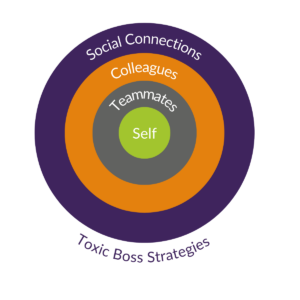
The place to start in building a strategy to cope with your horrible boss is in your own head. That’s where the most important action is happening. The stories you tell yourself will determine how much of a negative impact your manager can have on you. Work through these questions, either on your own or with a trusted friend, as a starting point.
Am I overreacting?It’s easy to take offense when your manager criticizes your work, passes you over for a plum assignment, or spends ages talking to your coworkers while avoiding you. If you start to form a story that your boss doesn’t like you, you’ll be looking for all the evidence to convince yourself that it’s true and ignoring any evidence to the contrary. That’s called the confirmation bias and it’s how our brains work—a bit of a bug in the code.
 To avoid whipping yourself into a froth over interactions that might be relatively minor, find someone you trust and share what you’re experiencing. Be as objective as possible. If it’s an email from your manager that got you worried, ask someone to take a look and see how the message strikes them. If it was an interaction in a meeting, describe what you saw and heard. Share how you’re interpreting the situation and ask, “how else could I interpret this?” or “what do you think she means by this?” or “how worried should I be?”
To avoid whipping yourself into a froth over interactions that might be relatively minor, find someone you trust and share what you’re experiencing. Be as objective as possible. If it’s an email from your manager that got you worried, ask someone to take a look and see how the message strikes them. If it was an interaction in a meeting, describe what you saw and heard. Share how you’re interpreting the situation and ask, “how else could I interpret this?” or “what do you think she means by this?” or “how worried should I be?”
If that trusted ally is on your team, ask if they could pay attention and give you any feedback about your interactions with your manager. They’ll be able to give you a more balanced view and potentially share a few tips about what works and what doesn’t.
If you don’t have someone you can trust, simply keep a record of your interactions by drawing a vertical line down the center of a piece of paper. Record the positive or neutral things on the left and the negative or unpleasant ones on the right. Counteract your confirmation bias by actively looking for evidence for the left side.
If even the most balanced, objective view of your relationship with your boss is that it’s toxic. Move to the next step.
How can I protect my self-esteem?If your boss doesn’t like you, doesn’t value you, doesn’t think you’re up to the task, you’re going to need to invest effort in protecting your self-esteem. No boss has the right or the power to make you feel bad about yourself.
If your manager says hurtful things about you as a person or your skills or traits, reframe them into statements about your behavior or the situation. For example, if they say, “you’re so sloppy,” reframe it as “I wrote a 2,000-word report and there were two typos.” Labels are more hurtful than behaviors. It’s distressing to think “I’m sloppy” but manageable to think “I left two typos in a report.”
For each hurtful comment, ask for a balancing comment. “I understand that I left two typos in the report. What parts of the report were good that I should repeat next time?” That way, you’re getting some balance in the equation. Most bosses will answer that question. If not, you could ask the same of a colleague or even of yourself. “I left two typos, but this report had way better graphs than I’ve done before.”
Just as Step 1 was about keeping a balanced view of your boss, it’s important to keep a balanced view of yourself, too!
United Front: Teammate StrategiesEnduring a terrible boss is awful but it’s not something you have to do alone. You have other people who are stuck with that terrible boss too!
[Caveat: if your colleagues don’t view your boss as toxic, this might be a case for some more soul-searching. Go back to Step 1 and consider whether there’s more in your control than you thought.]
How can our team keep functioning with a toxic boss?Many terrible bosses are bad for business: the disorganized, crisis-junkie boss; the conflict-avoidant, can’t-make-a-tough-decision-to-save-their-life boss; and the flip-flopping boss are just a few examples. If you’ve got a bumbling manager, your team is going to have to step in and manage yourselves.
 You can try to do this through official channels like using a meeting to force the point when you’re not aligned or when your manager’s priorities aren’t clear. If you’ve all got one another’s backs, it’s easier to say, “we need to know which of these 7 things you want to be finished first.” Similarly, if you know a colleague will back you up, you can be direct in asking, “last week, we committed to finishing the release of the Alpha project first. Shifting to the Owl project now will stall Alpha. Can we have two weeks to get Alpha done before we move on?”
You can try to do this through official channels like using a meeting to force the point when you’re not aligned or when your manager’s priorities aren’t clear. If you’ve all got one another’s backs, it’s easier to say, “we need to know which of these 7 things you want to be finished first.” Similarly, if you know a colleague will back you up, you can be direct in asking, “last week, we committed to finishing the release of the Alpha project first. Shifting to the Owl project now will stall Alpha. Can we have two weeks to get Alpha done before we move on?”
In some cases, the manager will follow your cue and do a better job. Sadly, it’s possible that broaching these topics will just make matters worse. In that case, establish a line of communication among your teammates that doesn’t include the boss. If you can’t get your manager to prioritize, have a huddle after the meeting to agree on what you’re all going to work on first. If the manager hasn’t defined the problem you’re solving or hasn’t assigned who is responsible, do it for them. Become a self-managing team. The point is not to be insubordinate or to act against the instructions of your boss. The point is to make up for it when your boss gives you no instructions.
How can my teammates support each other?In addition to stepping in to lead the team together, you and your colleagues can also form a strong community and a safe place for people to vent, ask for help, or just check their sanity. Become a safe person that your colleagues can talk to without fear of judgment or concern that you’ll spill what they said to the boss. Reach out with the odd meme or puppy video when you can tell someone’s having a rough day. Establish a “safe word” that people can use to indicate that they need support in a meeting, such as, “Edwards, what do you reckon?” where “reckon” means I really need you to take the heat off me for a minute.
Early in my career, I endured a boss with wildly unrealistic expectations and tumultuous mood swings. My teammates and I all recognized her behavior and banded together to support one another and to get the job done as best we could. They made it bearable and often fun. Twenty-five years later, I’m still dear friends with many of those coworkers. Relationships forged in fire, I guess.
Bolster Your Network: Colleague StrategiesIn addition to your efforts to stabilize the experience within your team, it’s also valuable to build bridges to people outside your team. If your toxic boss takes the whole team down with them, you want an escape route.
How can I get more support?Here are a few tactics you can use:
Reconnect with former teammates or managers who are now in other parts of the organization. Catch up, share what you’re working on, take interest in their priorities. Make sure you are on their radar.Volunteer for cross-functional projects that will provide exposure and opportunity beyond your current team. These projects will not only improve your visibility, but might also offer a meaningful place to contribute, access to feedback and coaching, and some respite from your normal tribulations.Participate in activities outside of your role. Join the company softball team. Volunteer for the fundraising campaign. Use any opportunity to be seen as a good corporate citizen.If no one knows who you are, you’re more vulnerable to the whims of your toxic boss. That might just mean that your boss can toy with you. It could also mean that no one will bat an eyelash when your manager tries to fire you. The more ties you have into the organization and the stronger your reputation as a great team player, the safer you are. Just be 100% committed to taking the high road. Never gossip or complain about your boss.
Is it safe to ask HR for help?One source of recourse for a truly terrible boss is to speak with Human Resources. In my experience, this is usually a safe and worthwhile option if you handle it the right way. HR professionals get more than their fair share of whining, complaining people and that approach is as likely to get you labeled as a toxic employee as it is to raise the alarm bells about your toxic boss.
Instead, approach HR in search of assistance and advice. State objectively what you’re experiencing and keep the conversation focused on you.
“How might I handle this situation appropriately?”
“What are my options in responding to this request?”
“Where have you seen people turn around a relationship before?”
“What advice would you give me?”
If you take this approach, you’ll be almost certain to get something valuable in return. If you go in swinging, your odds of success will depend on how accurate your description of the boss is, how many other people have complained, and how important or powerful your manager is in the organization. As I said before if you take aim at your boss, it’s just as likely it will blow back on you.
Invest in Resilience: Social Connection StrategiesThe final piece of the puzzle is to invest in your own resilience outside of work. The more worn down you let yourself become, the more likely that you’ll interpret ambiguous behavior as a sign that your boss is messing with you, that you’ll react inappropriately, or that you’ll spiral into something truly unhealthy. If you’re dealing with a toxic boss, you need your wits about you.
How can I destress from work?Resilience comes in short-, medium-, and long-term varieties.
Over the long term, your best source of resilience is in relationships where you feel loved unconditionally. If you’re neglecting your family because of the stress of work, make a deliberate effort to reconnect. If home is no less stressful than work, connect with old friends and people who love you for who you are.
In the mid-term, resilience is about healthy habits. Sleep is first and foremost among them. Work on your sleep hygiene. Sleep is followed closely by putting the right fuel in your body, getting movement in your day (preferably in nature), and giving in to moments of play and joy. If you’re trying to survive a toxic boss, you might be telling yourself, “I can’t afford to take a walk at lunch or go to my fly-tying class” but you’ve got it backward. If you’re trying to survive a toxic boss, you can’t afford not to.
In the short-term, if you’re in the midst of a Zoom call with your fire-breathing manager scorching your brow, don’t underestimate the value of micro-resilience strategies such as drinking water, squishing a stress-ball, lighting a scented candle, or looking at a picture of your smiling family. One of those might just be enough to get you through the call without being burned to a crisp.
How can I manage my bad boss?Here’s some advice for how to speak truth to power in any situation. Sticking to these rules can make it much harder for your toxic boss to unleash on you.
Catalog of Toxic BossesWhile these techniques will be effective with any form of a toxic boss, learning to bob and weave, to step around the landmines, requires that you understand what’s beneath your boss’ particular dysfunction. Here’s my current catalog of craptacular bosses with specific advice about how to manage each one.
Boss with Double Standards and Favourites
January 23, 2022
Toxic Team Dynamics
Is your team dynamic toxic? Does it detract from your ability to get the job done? Is it ripping you and your colleagues apart? Or just ripping you apart?
Maybe it’s not that extreme. Maybe it’s not insufferable, but it sure is unpleasant.
Or maybe you think everything’s fine, but the poison in your team dynamic is like lead in the pipes. You don’t know it’s there but it’s slowly making you ill.
Want to identify what might be going on? Dig in.
What are Some Common Toxic Teams?There are many ways your team dynamic can become toxic. I wrote about each of them in detail in my book You First: Inspire Your Team to Grow Up, Get Along, and Get Stuff Done. Let me give you the summary. Here’s the list of the toxic teams. Read them all or click on the name to jump right to the one that sounds familiar.
Crisis Junkie teams: lurch from one emergency to the next
Royal Rumble teams: yell-y, blustery, blowhard-y people
Bleeding Back teams: passive-aggressive, stab you in the back vibe
Spectator teams: not really teams at all. Collections of direct reports to the same person
Bobble Head teams: people going along to get along…uh-huh…yeah!
Crisis Junkie TeamsDefinition: A team that needs an urgent and immediate threat to come together.
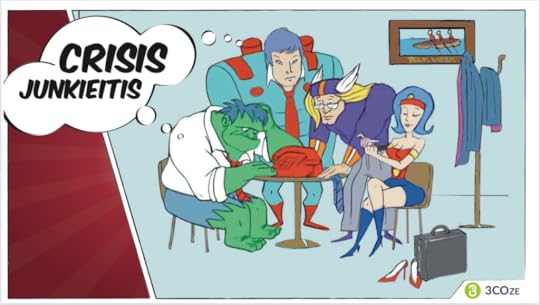
Original illustration by Peggy McEwan.
What does a Crisis Junkie Team look like?Crisis Junkie Teams struggle to get anything done. At least when things are calm. Only when it turns into a four-alarm fire does a Crisis Junkie team kick into gear.
What Causes a Crisis Junkie Team?Crisis Junkie teams are usually failings of the leader. Without the courage or the wherewithal to prioritize, make hard trade-offs, or ever ruffle any feathers, the leader leaves the team rudderless. Crisis Junkie Teams have:
Poor Role Clarity: no sense of what each person is responsible for leads either to friction as you step on one another’s toes or inaction when no one is sure who’s responsible for moving a task forward.No Team Priorities: without the necessary priorities, alignment, or role clarity, everyone works on what matters most to them.Insufficient Resources: too many priorities and too few resources to accomplish them all. You’re trying to boil the ocean and you never have enough gas.Politics and Infighting: sandbox issues lead to petty squabbles that the feckless leader doesn’t have the courage to addressWhat is the Impact of Being a Crisis Junkie Team?Crisis Junkie teams are costly to members and to the business. Common consequences include:
Knee-jerk reactions that are from old-playbooks and don’t fit the current climateRisky decisions and shoddy solutions based on an oversimplification of the situationDeteriorating relationships with other teams who feel they can’t depend on youFailure to execute strategyRoyal Rumble TeamsDefinition: A team where passion and enthusiasm are misdirected into personal and unproductive conflict among members.
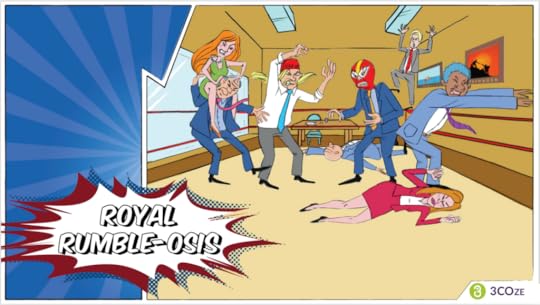
Original illustration by Peggy McEwan.
What does a Royal Rumble Team look like?With Royal Rumble Teams, it’s less about what they look like and more about what they sound like. The volume is usually set to 11. There’s lots of yelling, frequent ping-ponging back-and-forth, and very little listening.
What Causes a Royal Rumble Team?Royal Rumble teams are often a result of people with high IQ and low EQ (emotional intelligence). On the plus side, members of Royal Rumble teams are highly engaged, but often they’re passionate about their project, their ideas, and their vision of the future, but not a shared version of any of those. Royal Rumble Teams have:
Low Emotional Intelligence: smart, powerful people who throw their intellectual weight around trying to coerce people into seeing things their way. (It is also possible that EQ is high but wielded in a shrewd, manipulative way.)Bad Meeting Management: a weak or conflict-loving chairperson allows a discussion to devolve into a cage match.Individual Rewards and Recognition: high stakes rewards tied to individual performance that creates heroes and zeros.What is the Impact of Being a Royal Rumble Team?Royal Rumble teams are particularly noxious, particularly for anyone around the table who doesn’t like conflict. Common consequences include:
Slow decision making as no one considers alternatives or cedes territoryFalse choices between black and white optionsTurnover of people who seek a more civilized environmentEmbarrassing behavior and the accompanying damage to people’s reputationsBleeding Back TeamsDefinition: A team where conflict and differences of opinions are expressed through passive-aggressive means such as humor, gossip, and back-channel decision-making.
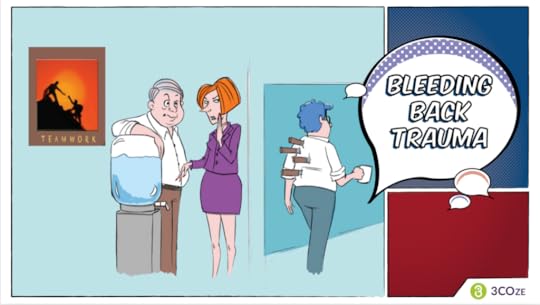
Original illustration by Peggy McEwan.
What does a Bleeding Back Team look like?Bleeding Back teams look amicable on the surface but if you listen in to the talk at the water cooler, things aren’t so rosy. There is little progress on a Bleeding Back team because decisions are either reopened or simply ignored by mutinous members.
What Causes a Bleeding Back Team?Bleeding Back teams are common in places where no one wants to appear oppositional or where they lack the skills to dissent productively. They’re full of people who think they’re being nice by stabbing you in the back but never in the front. Bleeding Back Teams have:
Lack of Feedback: people who are unable or unwilling to give feedback that nips passive-aggressive behavior in the bud.Low Trust and Safety: evidence or legitimate suspicion that surfacing issues is a bad idea.Backchannels: opportunities to get your way by going around the official decision-making protocol to leverage relationships with the boss or others with powerWhat is the Impact of Being a Bleeding Back Team?Bleeding Back teams slowly erode your faith in your team and make you question who you can trust. Common consequences include:
Poor decision-making because options and risks aren’t surfaced.Slow implementation as team members continue to challenge or refuse outright to enact team decisions.Inter-team confusion as colleagues in other departments get opposing messages from different members of the team.Mistrust and second-guessing of colleagues that tests trust and eats away at engagementStress. And More Stress. As you feel more and more like relationships are built on quicksandSpectator TeamsDefinition: A team where the whole is equal to the sum of the parts because individual members contribute only in their own areas, with little discussion or debate.
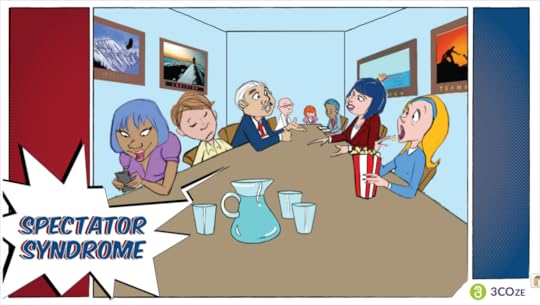
Original illustration by Peggy McEwan.
What does a Spectator Team look like?Spectator teams look like the people at a tennis match. Usually, there are only two people talking and everyone else is looking from one to the other. No one interjects. No one opens up the narrow thinking. No one spots risks or challenges assumptions. They just stare blankly.
What Causes a Spectator Team?Spectator teams are a result of the profound overwhelm people are experiencing. There is too much information, too many priorities for anyone to feel fully confident in their own area, let alone being informed enough to weigh in on someone else’s. Spectator Teams have:
No Team Mandate: clear priorities and tasks for each individual, but not overarching team purpose that requires everyone to co-create projects.Premium on Technical Expertise: the belief that only the deepest experts have anything worth contributing to a discussion.Different Capability: weaker team members who defer to those with better knowledge, greater experience, or just more ruthless debating skills.What is the Impact of Being a Spectator Team?Spectator teams are a giant waste of time. They create a false sense of security while churning out decisions that haven’t had the benefit of diverse thought. Common consequences include:
Wasted time in meetings where few are contributing.Siloed thinking that underappreciates different perspectives.Implementation struggles as issues left unexposed in planning start to pop up.Disengagement among team members who don’t feel they’re part of a team at all.Bobble Head TeamsDefinition: A team that is too aligned and doesn’t have enough diversity or dissent to make good decisions.

Original illustration by Peggy McEwan.
What does a Bobble-Head Team look like?Bobble Head teams look really, really happy. I think of them as the families on the game show Family Feud. Uncle Larry throws out a ridiculous answer and everyone hoots and hollers, “Good answer! Good answer!” There’s lots of nodding and agreeing on a Bobble-Head team. Because of this, they are often not recognized as toxic because toxic positivity is welcomed and even encouraged in some organizations
What Causes a Bobble-Head Team?Bobble Head teams are a result of placing greater emphasis on a harmonious team dynamic than on the quality of the team’s output. Bobble Head Teams have:
Too Much Familiarity: humans don’t know what we like, we like what we know.Homogeneity: groupthink caused by team members being too much alikeOverbearing Team Leader: some alignment is forced alignment where dissent isn’t tolerated.What is the Impact of Being a Bobble-Head Team?Bobble Head teams are dangerous because their risks are so insidious. Common consequences include:
Poor decisions because risks aren’t appreciated and therefore not mitigated.False confidence in the decision born of so many endorsements and so few challenges of ideas.Inter-group tensions that build as the team becomes an “us” and others become “them.”Loss of self for team members as they are constantly matching their pitch to the choir.Risk of blame when the poor decisions cause calamity and the finger pointers want someone to hold accountable.The Cost of Being on a Toxic TeamDid you recognize your team in one of these descriptions? People often tell me that their team is a melange, a potpourri, of several of these dysfunctions, or that the particular dysfunction depends on the day.
If your team is developing a toxic dynamic, it’s important to recognize it before it starts to impact your customers, your relationships, or your stress levels.
It’s not only poor team dynamics that can make you feel like you’re in a toxic work environment. Check out the four other definitions of a toxic work environment here.
Further ReadingAn Exercise to Expose Team Dysfunction in One Meeting
Why your volunteer team sucks and how to make it better
Top 10 Signs that Your Dysfunctional Team is Getting Better
January 16, 2022
Do You Have to Quit Your Toxic Workplace?
Are you worried that your workplace is toxic? Do you find yourself awake on Sunday nights fretting about the week to come? Are you emotionally spent by three o’clock on Tuesday? Do you dread each time you have to interact with your boss or your teammates? That’s no way to live.
In case you find yourself in this situation or if you have a friend or loved one turning to you for advice in a situation like this, let’s talk about options.
Options When You’re in a Toxic Work EnvironmentThe good news is that you might have more options than you think.
Option A: Should I Quit My Job?One option is to quit your job. And by ‘quit your job,’ I mean quit your organization. Resign. Vamoose. Later, alligator.
When It Makes SenseQuitting your organization makes sense if either:
 It’s your organization that’s toxic. The poison isn’t just in your cup, it’s in the well. This might be because the policies make you physically or psychologically unsafe. It might be because the organization is discriminatory. You might be expected to do work you’re not compensated for. Essentially, the rules of the game are unfair. ORYour part of the organization is toxic, and you can’t get out. In this case, you might work in a perfectly reasonable organization, but your department is corrupted, and you have no other options. If you’re a tax accountant and the CFO to whom you report is sinister, you likely don’t have an option to switch to another department.
It’s your organization that’s toxic. The poison isn’t just in your cup, it’s in the well. This might be because the policies make you physically or psychologically unsafe. It might be because the organization is discriminatory. You might be expected to do work you’re not compensated for. Essentially, the rules of the game are unfair. ORYour part of the organization is toxic, and you can’t get out. In this case, you might work in a perfectly reasonable organization, but your department is corrupted, and you have no other options. If you’re a tax accountant and the CFO to whom you report is sinister, you likely don’t have an option to switch to another department.If neither of those is true, quitting your organization might not be the only (or best) option for you. Take a look at options B, C, and D before handing in your notice.
Considerations Before QuittingIf you’ve concluded that your situation is so toxic that you must get out, the temptation is to leave immediately. It’s worth considering whether staying just a little longer might make things easier in the long run.
Things to think about:
Could you wait and save a small nest egg to give you some cushion before leaving?Are you able to find another job before resigning to avoid a resume gap?What could you do to leave on good terms so there’s no animosity?Option B: Should I Quit My Team?As I mentioned above, sometimes you work in a good organization, but you pull a lemon of a team. In that case, you don’t necessarily have to quit your organization, you might be able to quit your team. Apply for other positions in the organization. Swing your partner. Do-si-do!
Quitting your team makes sense if:
It’s your boss that’s toxic. Toxic bosses come in many forms, but top toxic boss characteristics would include abusive, insecure, childish, egomaniac, or incompetent. If your boss is a whack job but your organization is a keeper, you might just want to quit your boss. [Note: Don’t change jobs in the same organization if the whole place is polluted…well, unless you just need to change the scenery and it would be a relief to see the dysfunction through a different window for a while.]Your boss is okay but won’t deal with toxic coworkers. Sometimes you like your boss but can’t abide their willingness to put up with terrible employees. If working in your current team means putting up with incompetent, nasty, exclusionary pieces of work as teammates, you might need to quit your team to escape the toxicity.If neither of those is true, you’re likely to have a better path with Options C or D.
How to Quit Your TeamMonitor the internal job postings and apply to new positionsExpress your interest in broadening your skills or working in different divisions as part of development planning conversationsNurture relationships with other leaders through participation in cross-functional projectsOption C: Should I Quit My Role?Another, less drastic, option if you’re unhappy, stressed, or under-motivated is to look for a new role within your team. “Hey coach, can I play shortstop instead of first base this inning?”
If your organization is fine and your boss and teammates are swell (or at least tolerable), then it might just be your job that’s wearing you down. Roles can be toxic for several reasons. Maybe you’ve done the job too long and the monotony is rotting your brain. Or maybe your job is too difficult for you, and you’re exhausted by feeling like you’re running to stand still. Or maybe it’s the customers or other stakeholders you have to deal with that are burning you out.
How to Quit Your RoleSpeak with your manager about your desire to try something newFind a co-worker who might be interested in a swap and go to your manager togetherLook for secondment opportunities to projects that might give temporary reliefOption D: Should I Stay and Fight

When I say, “stay and fight,” I mean stay in your organization, in your team, in your role, and change the way you behave in hopes of changing your experience of work. Let’s be real, there are situations where you don’t really have the luxury of quitting. You can’t afford to be out of work. Your company is the only game in town. You haven’t found any opportunities that look better.
How to Fight for a Healthy EnvironmentIf you decide to stay, don’t just put up with a toxic situation. You probably have more ability to change things for the better than you think.
To be fair, I wrote a whole book about this. You First, subtitled “Inspire Your Team to Grow Up, Get Along, and Get Stuff Done,” provides a taxonomy of Toxic Teams and a roadmap for the things you can do differently to upend the unhealthy dynamic. If your team is the issue, it’s worth a read.
If it’s your boss that’s the issue, I’ve got some ideas for you too. I’ve classified crappy bosses into these categories and provided some suggestions on how to cope. Just follow the descriptor link that best captures your manager’s failings. (This list reads like the Seven Dwarfs from hell.)
Wimpy, Lazy, Toxicly Positive, Selfish, Childish, Favorite-playing, Egomaniacal, Abusive, Insecure, Incompetent, Flip-Flopping
And if it’s your colleagues who are doing the damage, here are a few thoughts depending on what you need to do.
If you’re trying to foster trust where it doesn’t exist. Try this. Or this. Or this.
If you’re working with someone who’s too sensitive, a bully, always droning on about the past, relentlessly negative, or easily offended, you can get some ideas by following the links
Did I miss any toxic bosses or toxic coworkers? Let me know and I’ll give you my best advice on those too.
No one deserves to work in a toxic environment. But if you find yourself in one, quitting isn’t necessarily the only or the best option. Spend some time reflecting on what’s at the heart of the issue and you might find that you’ve got more options than you thought.
Further ReadingHow to tell if you have a toxic work environment
How do I know when it is time to quit?
January 9, 2022
How to tell if you have a toxic work environment
Are you considering taking “The Great Resignation” as your pick in the 2022 business jargon drinking game? I wouldn’t recommend it unless you can hold your alcohol. With the current rate at which people are throwing the phrase around, I’d be blotto each day before I finished my morning newsletter reading.
To be fair, the Great Resignation does seem to be “a thing” and not just meaningless clickbait. Since mid- 2021, there has been a precipitous increase in people quitting their jobs (about 30% more than would be normal if you look at twenty years of history).
Of course, it’s not the first time that resignation rates have gone up. There have been upticks in turnover in the past when the labor market has been hot, and people could leave their jobs for an instant raise or promotion. But what’s interesting to me about the current spate of resignations is the extent to which I’m hearing of people leaving with no job to go to. It’s the difference between this…

And this…

And boy, it’s gotta’ be pretty grim in your bowl to consider the latter a better option.
That’s how poorly organizations have been in caring for employees’ physical and psychological safety. People are so exhausted, so worn down, so demoralized, dehumanized, and defeated that they’re quitting without a prospect of how they’ll earn a living.
That’s bad. Horrible, really.
As a leader, it’s an important time for you to think about life in your organization and on your team. How hospitable is the environment in your fishbowl? Are there toxins building up?
Signs of a Toxic Work EnvironmentFirst, let’s agree that toxic is a strong word. Its primary definition is “containing or being poisonous material especially when capable of causing death or serious debilitation.” Although there might not be many scenarios in your workplace that get to the level of death or serious debilitation, it’s worth considering whether or not there are factors that could legitimately fall under Merriam Webster’s second definition of toxic, which is, “extremely harsh, malicious, or harmful.”
Harmful. That’s not much of a stretch given the working conditions in a lot of organizations.
Evaluate your workplace on the following dimensions:
Does your workplace have toxic policies & processes?I scratch my head when people use the term “toxic organization” because I’m not sure what an organization actually is. The closest I can come to nailing down the amorphous, abstract construct known as an organization is to consider the organization as the policies and processes that exist beyond any single individual. People can come and go, and the explicit rules of the organization remain.
Does your organization have toxic policies or processes? Consider these indicators…
Working conditions that are unhealthy (unhygienic, scorching hot, frigidly cold, cramped, lacking privacy, back-breaking)Official working hours, break times, or scheduling systems that leave employees with little control or ability to accommodate their personal livesDiscriminatory hiring, performance management, or promotion practices that systematically disadvantage certain groupsLow compensation that doesn’t provide a living wageThese are only a few examples but anything that is codified into the rules of the organization that could be considered harmful should be on your radar. Which policies in your organization might legitimately be considered toxic by employees? What can you do to raise the flag and to have those practices and policies reconsidered?
Does your workplace have a toxic culture?If the notion of “an organization” is nebulous, culture is even more elusive. Yet, there really is such a thing as a toxic culture. It comes down to the norms that dictate how people in your organization behave. These are the unwritten rules by which your people operate. And boy-o-boy, can they be insipid and insidious.
Does your organization have a toxic culture?
Resistance to new people and rejection of ideas that disrupt the status quoZeros and heroes where some people have clout and others are ignoredPassive-aggressive behaviors such as gossip, undermining, or sarcasmOffice politics and opaque back-channel influence strategiesRelentless positivity and unwillingness to tolerate dissent or disagreementAgain, I could have written a list the length of my arm of examples that suggest a toxic culture. You get the idea. Do the unspoken rules of the organization tolerate, allow, or even condone nasty, exclusionary, unproductive, or demoralizing behavior?
Does your workplace have toxic leaders?Uh-oh. This is you. Is it feeling a little warm in here? Of course, it’s not only you, but also any of the people with power and control who might be making life miserable, either intentionally or unintentionally, maliciously, or innocently. Do any of these sound familiar?
Failure to prioritize and constant pressure to deliver an unachievable workloadHarsh, critical, dismissive judgments masquerading under the guise of feedbackDouble standards and inconsistent treatment between favorites and flopsPoor planning that necessitates rework and firefightingMicromanagement and constant questioning and meddling in people’s workThe vast majority of people who take on management responsibility are decent human beings. Somehow, the combination of pressure and power corrupts. Scary fact, did you know that studies show that empathy declines as power increases. Zoinks! Not good. Take a long hard look at your leadership behaviors and see if they’re harming the people who work for you.
Does your workplace have toxic employees?It’s not only those with power that can make life inhospitable in your organization. Employees are affected strongly by their teammates and colleagues and sometimes that’s not in a positive direction. Is there evidence of any of these destructive behaviors among the members of your team?
Failure to deliver on commitments that affect other employees’ ability to meet the expectations of themSocial exclusion and shunning of certain team members from the social interactions of the teamGossiping about teammates with colleagues or the managerHarsh, uncivil, disrespectful interactions characterized by derision, snide remarks, or personal attacksOverstepping with narcissistic, heroic, save-the-day behavior that prohibits coworkers from contributing or devalues their contributionsIf these kinds of things are going on under your watch, you’re on the hook for them. And rest assured that some of the toxic coworkers might be your favorite employees because they’re aces at managing impressions. It’s not ok to be clueless or bamboozled by people who treat their coworkers poorly—even if those people deliver for you.
Do you have toxic customers?Now we’re into the really interesting stuff. It’s possible that you are presiding over a toxic  workplace not because your organization has draconian policies, not because the culture has soured, not because you’re a jerk, or
workplace not because your organization has draconian policies, not because the culture has soured, not because you’re a jerk, or
because your employees are…it’s possible that coming to work has become a threat to people’s physical or psychological safety because your customers are terrible.
Wow. That’s a lot to deal with. How far we’ve come from the heady days of “the customer is always right.” In this day and age, we’ve got flight attendants having to duct tape unruly customers to their seats (seriously, if you didn’t see the video, watch it here).
Any chance that your customers should come with a Surgeon General’s warning?
It might look like this…
Abusive behavior, including yelling, unwanted physical contact, aggressiveness (hats off to all the nurses who endure this kind of punishment as a regular part of the job)Rule-breaking and attempts to contravene organizational policiesUnrealistic expectations and constant threats to take their business elsewhereNickel and diming for every single item with no respect for the value they’re gettingDisorganization and changing expectations that lead to endless reworkYup, that’s a terrible prospect but it’s not far-fetched to think that you could be losing employees because your customers are jerks. It might not be your fault, but it’s still your problem. What are you going to do about it?
Physical and Psychological SafetyIt’s your job to foster a workplace that is both physically and psychologically safe for your employees. If working in your team has become toxic for any of the reasons I outlined, you better do something about it. If you can’t, my guess is that it’s not a safe place for you either. Maybe it’s time to update your resume and join the Great Resignation.
EpilogueTo be fair, I believe that the term “toxic” is getting bandied about far too liberally. “Toxic” is no longer reserved for the types of noxious workplaces where you might be screamed at for not being able to keep up with an unreasonable workload or forced to pee in a bottle if you want to make your quotas. I’ll be back with some examples of where employees are overreacting and how you might address it if you or your organization is being unfairly labeled as toxic. Stay tuned.
Further ReadingA Different Take on Psychological Safety
Are you working with a toxic team?
The Vicious Cycle of Bad Behavior
December 12, 2021
8 Techniques to Make Meetings More Effective (Part II)
In the previous post, I provided four techniques you can use to set your meetings up for success. This post includes four strategies for facilitating a great meeting.
More Effective Meetings5. Scan Before DivingOnce you’re in a meeting and starting to discuss a topic, save yourself both time and frustration by getting a lay of the land before going deep on any one aspect of the discussion. This is easier said than done because many participants can’t help themselves but jump into the weeds when the first concrete example is provided. That’s a sure way to spend half of your meeting time on 1/32 of the problem. Instead, ask your well-prepared participants to share what they see as important aspects of the discussion. Write the components down for all to see. Continue until you’ve got the major sections mapped.
The item sponsor (for more on the role of an item sponsor, read Part I) should then negotiate on the order of discussions and the depth into which you’ll go on any specific topic. Use a timer to stay on track. If someone goes off on a tangent in section one, remind them that you’ll cover that issue in section three. If they add an entirely new topic, figure out where it fits and add it to your prioritized list. If you want to use my ridiculously structured 6-List method to meeting facilitation, you can find it here.
6. Prioritize Juicy Conversations and Productive ConflictMeetings that are just about regurgitating last month’s sales numbers or listening to someone read a PowerPoint presentation aloud are the worst. Use your meeting time wisely by focusing on diverging, disagreeing, and debating. What you’re looking for are juicy conversations. I define a juicy conversation as one that’s deep, probing, uncomfortable, and goes beyond the normal safe, boring talk that consumes most meetings.
If you followed the advice in my previous post to set up your meeting well, you’re already much more likely to have a juicy conversation. Primers are particularly useful for ensuring that the more thoughtful, deliberate, or introverted folks have had time to prepare and won’t throw their brilliant idea in at the last minute. In addition to having item sponsors and providing primers, here are some things you can do to focus your meeting on juicy conversations and conflict:
Provide a prompt to get people thinking differently—to change the frame. For example, “We’re a $50 million company today. What would our systems need to look like if we were a $500 million company?”Ask big open-ended questions. You’ll learn as much from how people interpret the question as you will from the specifics of their answer. This is when you figure out that you’re solving for a whole variety of different issues, not just the one or two you had already thought ofStart with small group discussions to allow people to trial controversial ideas. Getting a discussion warmed up with people talking in pairs or triads can create enough psychological safety for the contentious issues to outBe vulnerable first. Particularly if you’re the team leader or the item sponsor, if you’re willing to say something that raises eyebrows, you’ll be more likely to get others to reciprocate. Try starting a sentence with “I’m worried that…” or “I fear that…” or “What if it’s not…”Get out of the way. Frame the question. Model vulnerability. Then be quiet. If you must speak, use a question or a two- or three-word comment at most. The rule of fostering juicy conversations is to zip it or clip it.Leave the silence. Wait people out. Let them squirm.Reward the most uncomfortable comments. Even if you’re gobsmacked and the best you can say is, “Wow, I’m glad you said that!” you’ll get more delicious, diverse suggestions if you celebrate the brave souls who rock the boat.The vast majority of topics I hear taking up meeting time could be replaced by email. They are about informing, reviewing, or highlighting. Reserve your precious time together for diverging, adapting, modifying, and testing.
7. Formalize the Meeting CloseI’ve written about the importance of a strong meeting close before. You can get all the steps here. Let me call out the one segment that is most closely tied to making your meetings more effective, which is ensuring that everyone is aligned on what you’ll do after the meeting.
The easiest and best way to do this is to have someone taking notes during the meeting that can be projected for everyone to see at this point. (If you’ve been using my ridiculously structured meeting facilitation approach, which I shared in #5, above, then this step will be simple because you can just turn to what I call “Page 5.”) When you share it, the list should already have each action item, a description of the next step, the name of the person who is responsible for doing it, and the date by which it will be completed.
Stop for a moment and let everyone poke at the list. Are there any action items that aren’t clear? Do you need to define any terms that are open to misinterpretation? Is there anyone who needs to be consulted? Are there any milestones in advance of the deadline date?
The big advantage of having this list digitally is that the moment everyone agrees, it can be sent as an email or uploaded to the team’s Slack or MS Teams site. Then everyone’s working from the same commitments list.
There are other components of an effective meeting close. You can read about them here.
8. Evaluate on the SpotBefore anyone leaves (I’m imagining an old western with a cowboy drawing his pistol and yelling “don’t anyone move.”) take a moment to evaluate how the meeting went. I’m amazed how much of the kvetching and complaining about meetings takes place at the water cooler rather than anywhere it can be heard and translated into better practices. That’s passive-aggressive and it’s self-defeating. Instead, take a moment to go around and evaluate the quality of the meeting on these measures:
Did we have the right topics on the agenda? Which were the most valuable? Which were the least valuable? Were there any that didn’t need a meeting?Did we have the right discussions? Did the primer set up the conversation well? Did we move through the discussion at the right level and in the right order?Did we have the right dynamic? Did people raise dissenting perspectives? Did we get to the juicy conversations? Were we respectful of one another? Did we follow our ground rules?One of the ways I love to have these course correction conversations is a technique I got from Andrew Davis. Participants simply answer the questions above in two categories: what they loved about the meeting and what they wish could be true in future meetings. For example, “I loved that we brought the Agile Product Development method to this table. I was glad that Sales got a chance to weigh in. What I wish is that we’d had a bit more information in advance on how other organizations have integrated Agile into their sales approach.”
Now, if you read Part I, you already know that last thing I’m going to say. Yup…
Build Your Next AgendaIt was the first in the list of 8 techniques to make your meetings more effective and it’s where we’ll wrap up. Set your next meeting up for success by collecting the agenda items now.
Great meetings require a little discipline. If you set things up well and have just the right amount of structure, then you can relax and let the juicy conversations flow. You’ll find you need fewer repeat meetings where you cover the same ground over and over. You’ll also find yourself looking forward to meetings because they’re efficient ways to get aligned so you can get going. Wouldn’t that be nice!?!
Further Reading8 Techniques to Make Your Meetings More Effective (Part I)
8 Quick Tips to Shorten Your Meetings
If Meetings Suck, Why Do You Keep Going?
December 5, 2021
8 Techniques to Make Your Meetings More Effective (Part I)
How much of your week do you spend in terrible meetings (and by terrible, I mean meetings with poor planning, unclear agenda, facile facilitation, and no clear outcome)?
I’m going to share eight things you can do to set your meetings up for success. This post includes the four things you can do before your meetings. The next post will cover the four things you can do during the meeting.
1. Set Meeting Ground Rules/PrinciplesTake the time to set ground rules or guiding principles for how your group is going to work together. This doesn’t need to be a long and drawn-out exercise. Even five minutes spent contracting on how people will show up is time well spent. You can try using these questions.
What are our expectations around:
Coming prepared? (How far in advance do we need materials? What happens if we don’t prepare? More on that here.)Paying attention? (Are we cool with devices in the room? Is it ok to tune out?)Listening? (What’s our standard for effective listening? You can borrow mine here.)Having conflict? (What’s our obligation to add diverse perspectives? What are our conflict norms? More on that here.)Decision-making? (How will we clarify the decision-owner? What’s allowed if you don’t own the decision? Check out my view on whether or not teams decide here.)2. Build Your Next Agenda at the End of Each MeetingAnother reason meetings tend to suck is that too little thought goes into getting the right agenda. More often than not, I see administrative assistants setting agendas on behalf of their leaders. Those agendas are seldom packed with the most important items. Instead, they’re filled with topics raised by the squeaky wheel, transactional items the EA needs to push through, and a big chunk of roundtable time where heaven knows what melange of minutiae will arise.
Avoid the lackluster agenda by using a few moments at the end of each meeting to propose agenda items for the following meeting. Capture anything that was left unfinished in the current meeting. Add topics that needed more preparation. Throw in an emerging issue that you need some time exploring. Using five minutes at the end of your meeting to set the next agenda will yield better quality conversations in the future.
3. Assign an Item SponsorAnother reason to set the agenda for your next meeting at the end of your current meeting is that it allows you to appoint an item sponsor for each item you’ll cover. This is probably the single most important strategy for improving your meetings. The item sponsor has a variety of responsibilities, including:
Framing the questions to be addressed in the meetingCollecting, analyzing, synthesizing, and communicating the context and content required to inform the discussionPreparing any guests to add value in the meeting by briefing them on what the team is looking for and coaching them on how to be successfulFacilitating the conversation in the meetingSoliciting any feedback about the guests and disseminating it to themCollecting the action items and follow-up and finding a spot to follow up on progressConnecting the quality and value of an agenda item to an individual, rather than diluting the accountability across the whole team, really ups the stakes. How effectively someone plays the item sponsor role should be part of their performance management and a key indicator of the leadership potential.
4. Distribute a PrimerOne of the responsibilities of the Item Sponsor is to curate and communicate the content and content required for an evidence-based discussion (did ya’ see that one in the bullets in #3?). Well, that communication comes in the form of a primer. I use the term primer, rather than pre-read because I want to move from the passive idea of skimming a document to the more active concept of priming yourself for the discussion, debate, and deliberation required in the meeting.
A primer should include a section on context (why are we talking about this) and on content (what are we talking about). In addition to the material you want people to read, the primer should include call-outs and questions that draw the readers’ attention to the questions that will be posed in the meeting.
When you’re setting your ground rules (see #1 above) you can decide how much lead time you need between distributing a primer and the meeting. Once you move to this approach, there should be a lot of heat both on the item sponsors for building effective primers and getting them out on time and on participants for reading the primers and coming prepared with some thoughts already formed.
Set Up for SuccessYour meeting hasn’t even happened yet but, I promise you, if you’ve done these four things, there’s already an 80% chance that your meeting will be efficient, effective, and worth your time. In next week’s post, I’ll get into the heart of meeting facilitation and the things you can do to get to the heart of the issues and get out with clear marching orders. You’ll find a few related posts that deal with meeting shenanigans in the further reading section.
Further ReadingDealing with the person who skips your meetings
Why you shouldn’t go to that meeting
Are you meeting at the wrong time?
November 28, 2021
Seeing Through Diverse Lenses
During my annual NOvember campaign on LinkedIn, I challenge myself to find things I can say “no” to in an effort to liberate the time and energy to say “yes” to the things that matter. In this process, I hope to become happier, healthier, and more productive. To date, in the three years I’ve been committing to NOvember, I’ve said “no” to 89 obligations, activities, and mindsets that have become plaque restricting the blood flow in my life (I’m publishing the final “no” of 2021 tomorrow.)
Different LensesYesterday, my “no” represented a fundamental shift in how I want to think and learn and grow from now on. I decided that I need to get serious about saying “no” to looking at the world through my default lenses. Here are the things that I would classify as my defaults:
US-centric: The books I read, the movies I watch, the academics I admire are predominantly American. Americans are amazing. There is something truly special about the country and its culture. Yet, it’s only one country and increasingly, I’m disillusioned by how Americans think about work. Time to learn from other models around the world.White Anglo-Saxon: The people I engage with and learn from are mostly white and not even just white, they’re Canadian, American, British, and western European. I’m even missing huge swaths of white cultures and ideas. Anglo-Saxons are fantastic, we invented the steam engine and the telegraph, but there’s more to the world. Time to learn from more Indigenous voices, more ancient and modern Asian and South Asian wisdom, more from the African continent, heck, more from BIPOC people who live in my own city.Highly educated: I have a Ph.D. My husband has a Ph.D. My brother and his wife both have PhDs. My best friend has a Ph.D. I loved getting an education at a top-rate university. But my form of education is not the only form of education. I don’t know enough people who have been educated through other means. (I do know one who traps in the far north and his intelligence in the natural world has always blown me away.) I need to learn from people who have been educated by apprenticeship, educated by elders, educated by tragedy, or educated by doing.Straight and cis-gendered: I am primarily (although thankfully not exclusively) surrounded by straight and cis-gendered people. My world is decidedly heteronormative. I need to read and learn from people at all different places on the spectra of gender and sexuality.Economically advantaged: I live in a nice house, in a nice neighborhood, in a wealthy city, in a G7 country. My perspectives are skewed by the affluence that surrounds me. I need to learn from people who know what it’s like to live precariously. I need to learn from those who live without. I need to glimpse the world through their eyes. A visit in 2018 to the floating villages of Cambodia taught me more about this in one day than my formal education taught me in 21 years. I need more.Professional services: I have worked my entire career in professional services and many, many of the people I talk to are consultants and coaches. I adore them. They mostly think like me. It’s comfortable and familiar. There are other industries that I need to learn from. I need to get back to my love of factories and industrial environments. I need to work with people in healthcare and the service industry.Cerebral: I wrestle the crap out of things with my brain. That’s what I’ve been rewarded for doing—comprehending, analyzing, synthesizing, evaluating. I need to get out of my head and start feeling, intuiting (is that a word?), sensing. I need to learn more about the soma and embodiment and connection.That’s all I’ve got for the moment. It’s a pretty decent list, I think.
I’m sure you will help me add to the list because the problem with our defaults is that we don’t even recognize them. They’re the proverbial water to the fish.
This NOvember, I’m saying “no” to my defaults and making a conscious effort to tune in to a diverse chorus of global voices. One simple LinkedIn post asking for recommendations has yielded dozens of brilliant people I’m now connected to (take a look here and follow some of these amazing people). It will take more effort to connect with the people who aren’t on LinkedIn. It will be worth it.
What are your defaults and how will you say “no” to them?
Further Reading
Want to see the most popular “no’s” from this year’s NOvember, check these out:
Say “no” to doing it right now (using these forms of “not until”)
Say “no” to micromanagement (using this technique of “I know you know”)
Say “no” to flinging facts at fights (get to the values instead)
November 21, 2021
We are planning all wrong
Even if you’ve got a Plan B, there’s no excuse for making a completely unachievable Plan A. If your plans are based on 100% productivity, that’s not a plan, that’s a pipe dream. Let’s talk about better Plans A. (And stay tuned below for the answer to what percent capacity you should plan for.)
Planning All WrongI see it all the time. Teams and leaders plan their time by estimating how long it will take to do a given task (usually wildly optimistically) and then do some simple math to determine how many tasks they can therefore fit into the day, week, or month. They have a beautiful, accurate-looking timeline that they commit everyone to deliver.
Does your team do this?
It’s a recipe for disaster.
A blueprint for burnout.
A catalyst for crises.
[Side rant: If you’ve ever worked in professional services, you’ll have lived the tyranny of “utilization” and the expectation that you can bill clients 37.5 hours per week while somehow magically invoicing, attending professional development, selling new work, oh…and filling in the blasted timesheets to prove it!!]
Perfect productivity is not a thing. Sh!t happens. And sometimes it’s not even sh!t that happens…super-duper stuff happens. Awesome opportunities arise. And if there’s no slack in your system, you can’t cope with the bad stuff and you can’t capitalize on the good stuff.
Without any slack in the system:
Colleagues have no time to collaborate or help out because they’re already fully committedOne team’s small misstep backs up the schedule in a supporting team and ripples on in the supporting team’s inability to then help a different team (If you’ve ever worked with a bad general contractor, you know this plumbing, electrical, drywall trifecta of terror)You have no time to change approach, even if it’s a change for the better because the retooling time takes you off trackYou are totally screwed up by unavoidable weather events, supply chain backlogs, traffic jams and have to use personal time to make up for it.I wonder what proportion of the much-ballyhooed Great Resignation is a result of the completely unrealistic expectations we’re putting on people. Planning for 100% capacity is not only inefficient but also inhumane.
I took to LinkedIn to rant about the problem of planning for full capacity and I was overwhelmed with the messages in support of slack in the system. Here are some of the benefits people shared:
Buffer leaves space for greater creativity. If you have time to experiment, you can discover new and better approaches (Deepak Agrawal & Stacy Brookman)Planning for less than 100% productivity leaves space for you to ruminate and for ideas to percolate. That’s where wonderful disruptions are born (Dr. Caroline Brookfield)A little extra staffing allows you to handle illness and absence without throwing off the whole systemDowntime gives your mind time to process information rather than becoming completely overwhelmedHaving a little wiggle room allows time to revisit, learn, and close feedback loopsAnd I’m not ending the list without saying that when we leave some slack in the system, we have time to pee between meetings. Amen to time to pee between meetingsWiggle RoomOne of the most fun things to come out of my LinkedIn post was at first a comment, and then a conversation, and then a connection with data science executive and host of The Effective Statistician podcast, Alexander Schacht. Alexander shared with me an episode of the podcast where they talked about capacity planning in complex systems. He had been inspired by an 11-minute delay on a Deutsche Bhan trip that resulted in a cascade of delays and travel headaches. That provided the perfect excuse to talk about capacity in complex systems.
It turns out the mathematicians are studying exactly this (of course they are). And there’s an answer. It’s 80-85%. If you plan for 80-85% capacity, then small bumps on the road don’t accumulate and amplify. With 15-20% slack, you can go around the obstacle without getting off track.
So, stop. Really. Just STOP thinking you can plan perfectly and not leaving room for mistakes, or changes, or shifting priorities, or emergencies, or snow days, or delays.
Start planning for 80% Prevent the domino effect of one little issue triggering a landslide. Bake in some breathing room and reduce burnout.
Building your GANTT chart assuming 37.5 hours of productivity a week from each and every employee is actually hurting your productivity, eroding efficiency, and contributing to the great resignation.
Further ReadingEnough about Workload, the Problem is Thoughtload
November 14, 2021
End Your Meetings Properly
You know how a gymnast loses major marks if they don’t “stick the landing?” That’s how you should think about your meetings. I don’t care how many flips and twists you get in, if you don’t stick the landing, they don’t count.
It’s fascinating to me how much time is invested in meetings and yet how little investment is made in ensuring the meeting translates into action. And when I say “fascinating” it’s in that euphemistic Canadian way that really means “mind-boggling, ridiculous, WTF?!?”
You won’t find me on the bandwagon of people who love to vilify meetings. The mission statement of our company is to “help people achieve amazing things together.” It’s hard to achieve amazing things together if you’re not willing to be together occasionally. In fact, after reading an article that made meetings seem worse for you than smoking or playing in traffic, I wrote this article in their defense.
What I am keen to do is to improve the structure of meetings, better match the frequency and tone of meetings to their purpose, and add a few healthy behaviors that make meetings more efficient and effective. One of the best things you can do to make your meetings more effective is to end them properly.
That’s not usually what happens.
Instead, with about 10 minutes left in a meeting, just as people are getting twitchy and starting to think about what they have next (probably another meeting), that’s when someone tables a new item with no forewarning. “Oh, hey…” (it usually starts with a casual “oh, hey, while I’ve got you…”) I call that “throwing in another twist” and it’s tempting, but it’s a bad call because it makes it way less likely that you’ll stick the landing.
The problem with skipping a proper meeting close is that attendees aren’t clear on what they’re accountable for and therefore less likely to fulfill their obligations. Not only does that compromise the productivity of the team, but it also starts to erode trust when team members start to worry that they can’t count on one another to deliver.
Instead of rushing off at the end of a meeting with no proper closure, reserve 10% of any meeting to stick the landing. That means if it’s a 50-minute meeting, stop with 5 minutes left. If it’s been a 2-hour meeting, save 10 minutes.
End Meetings ProperlyProject the PlanOnto the screen, project the running tally of commitments that you made during the meeting. (You’ll need someone taking notes throughout so that it’s as simple as them sharing their screen.) If anything is unclear, clarify it. If there’s a plan without a champion or a deadline, assign them.
Set the Next AgendaNext, decide what issues from your meeting will need a follow-up and decide which meeting agenda they will get assigned to. Highlight any topics that need attention so that you’ve got time to prepare before that discussion.
Agree on CommunicationDecide what messages from the meeting will be communicated and spend a couple of minutes making sure that you’re aligned around important language. Determine what will be said, to whom, by whom, and by when. If the note taker documents this, the notes can go out immediately.
Evaluate the MeetingFinally, take 30 seconds to evaluate whether the meeting had the right content. Don’t be shy to say if something could better have been addressed through an email and make sure to recognize anyone who did something that contributed to an effective meeting.
Then, when you stick the landing, you can throw your arms to the side, puff out your chest and do a giant ta-da! Not only did you do some amazing acrobatics but you also stuck the landing.
Further ReadingHow to Improve Hybrid Meetings
Why you shouldn’t go to that meeting
November 7, 2021
Stop With the Generational Jokes Already
It seems there are few things we like more than a generational stereotype. Based on my time hanging around conferences and water coolers, I’ve realized we’re pretty comfy describing hundreds of millions of people with a single sentiment. Boomers don’t get technology, Gen Xers are cynical loners, and millennials think they know everything.
Sure, the jokes are funny…
“How many boomers does it take to change a lightbulb?
None — they’ll all resist change even if it makes the world a brighter place.”
“I am getting so sick of Millennials and their attitude.
Always walking around like they rent the place.”
…but when the jokes and one-liners lull us into a lazy reliance on stereotypes, they do us a disservice.
Generational Differences?Research doesn’t support the existence of generational differences in the workplace.
A large-scale meta-analysis shows negligible differences in work outcomes across generations. One generation isn’t more committed, more loyal, more engaged, or more satisfied than another.
Another interesting study of 3,325 people looked at personality differences among people of different generations. Extroversion, openness, and agreeableness were not significantly different among Boomers, Gen Xers, and Millennials.
So why do you sometimes feel like your younger/older colleagues are from a different planet? Well, there are a couple of other explanations for what you’re interpreting as generational differences.
Age and StageIn that study on personality differences, there was one notable difference—on emotional stability. Baby Boomers scored higher on emotional stability (66/100) than Millennials (53/100). People over 70 were even higher!! But before you feel vindicated and resume telling your jokes, consider another possibility… that people in their 20s are different than people in their 60s, 70s, and 80s.
When you’re just out of college, not yet having a mortgage or kids, still serial dating looking for a life partner, trying to figure out working for a living… it’s not hard to understand why you’re your emotional stability might be a bit wobbly at times.
And that once you’ve lived most of your life, seen it all, survived child-rearing, horrible bosses, and the loss of your hair (or its migration to strange new locations) … that maybe you become a bit less neurotic. You stop sweating the small stuff.
Many of the behaviors you might interpret as generational differences are just differences in age and stage. If you could time travel yourself to that age, you might be more like your colleague than you think. Before you chalk up Bianca’s disengaged behavior to her being a card-carrying cynical Gen X, consider whether she’s just a 45-year old exhausted by three teenagers at home.
Individual DifferencesThe biggest differences between you and your colleagues probably aren’t generational differences or differences in age and stage. The biggest differences in how you react in a given situation (or in what you pay attention to, value, or reward) are probably because you’re different people. You have your own unique experiences, relationships, skills, traits, and motivators. Individual differences within a generation are massive compared with differences across generations.
Why it MattersThere’s a great article in Harvard Business Review (King, et al., 2019) that shows the harm done not only by holding stereotypes of other generations but also by buying into stereotypes about our own. They argue that the big problem is not that these generational differences exist, but that people believe they exist, and then those beliefs affect how people collaborate with colleagues across the generations. These researchers showed alarming impacts of these false beliefs on training and learning, on intra-team conflict, and on mentoring.
Next time you want to crack a joke about the millennials in your office, stop. You’re reinforcing a harmful stereotype and making it harder for everyone to get along.
Further ReadingThe Key to Preventing Generational Tension Is Remembering That Everyone Wants to Feel Valued in Harvard Business Review
Hey men! Try leaning out a little
How to manage workers who are older than you



